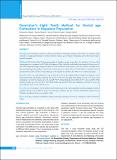Please use this identifier to cite or link to this item:
https://hdl.handle.net/20.500.14356/1498Full metadata record
| DC Field | Value | Language |
|---|---|---|
| dc.contributor.author | Subedi, Nuwadatta | - |
| dc.contributor.author | Parajuli, Umesh | - |
| dc.contributor.author | Paudel, Ishwari Sharma | - |
| dc.contributor.author | Mallik, Mukesh | - |
| dc.date.accessioned | 2023-05-14T09:44:45Z | - |
| dc.date.available | 2023-05-14T09:44:45Z | - |
| dc.date.issued | 2020 | - |
| dc.identifier.citation | SubediN., ParajuliU., PaudelI. S., & MallikM. (2021). Demirjian’s Eight Teeth Method for Dental age Estimation in Nepalese Population. Journal of Nepal Health Research Council, 18(4), 686-691. https://doi.org/10.33314/jnhrc.v18i4.3119 | en_US |
| dc.identifier.issn | Print ISSN: 1727-5482; Online ISSN: 1999-6217 | - |
| dc.identifier.uri | http://103.69.126.140:8080/handle/20.500.14356/1498 | - |
| dc.description | Original Article | en_US |
| dc.description.abstract | Abstract Background: Demirjian’s method is widely used method for dental age estimation. This study was conducted with objectives of applying Demirjian’s 8 teeth method to estimate age in Nepalese Population and to determine Nepal-specific formulas. Methods: We had used the Orthopantomographs of Nepalese people of age above five and below 23 years. The radiographs were compared to the ‘Tooth Development Chart’ and each tooth studied was assigned with any one of the 10 developmental stages using Demirijian’s 8 teeth method and total maturity scores determined. Formulas were derived using regression analysis, wherein the total maturity score obtained for each individual was considered as the independent variable and the corresponding age as the dependent variable in the STATA 15.1 statistical program. Results: There was underestimation of age in both the sexes by the original method. Regression equations were derived for males and females separately for age five to 18 years and again after adding cases up to 23 years. The estimation was better for males up to 18 years [R2=0.94, Mean Absolute Error (MAE) 0.747 years and SD 0.644] than for females up to 18 years (R2 = 0.89, MAE 0.886 years and SD 0.925). The estimation was better for up to 18 years than for up to 23 years in both sexes. Conclusions: Demirijian’s 8 teeth method underestimated age in the study population and thus population specific equations based on the method are better for dental age estimation. The age estimation utilizing the equations from Nepalese population has given acceptable results. Keywords: Age estimation; demirijian’s method; dental age estimation; forensic age estimation; tooth development chart | en_US |
| dc.language.iso | en | en_US |
| dc.publisher | Nepal Health Research Council | en_US |
| dc.relation.ispartofseries | Oct-Dec, 2020;3119 | - |
| dc.subject | Age estimation | en_US |
| dc.subject | Demirijian’s method | en_US |
| dc.subject | Dental age estimation | en_US |
| dc.subject | Forensic age estimation | en_US |
| dc.title | Demirjian’s Eight Teeth Method for Dental age Estimation in Nepalese Population | en_US |
| dc.type | Journal Article | en_US |
| local.journal.category | Original Article | - |
| Appears in Collections: | Vol. 18 No. 4 (2020): Vol. 18 No. 4 Issue 49 Oct-Dec 2020 | |
Files in This Item:
| File | Description | Size | Format | |
|---|---|---|---|---|
| 3119-Manuscript-20001-1-10-20210122.pdf | Fulltext Download | 363.9 kB | Adobe PDF |  View/Open |
Items in DSpace are protected by copyright, with all rights reserved, unless otherwise indicated.
